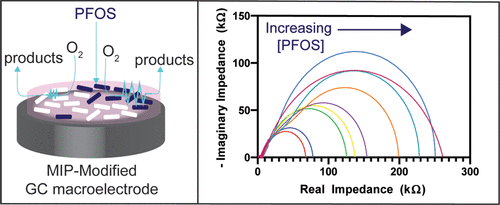Our official English website, www.x-mol.net, welcomes your
feedback! (Note: you will need to create a separate account there.)
Electrochemical Sensing of Perfluorooctanesulfonate (PFOS) Using Ambient Oxygen in River Water
ACS Sensors ( IF 8.2 ) Pub Date : 2020-11-10 , DOI: 10.1021/acssensors.0c01894 Rebecca B. Clark 1 , Jeffrey E. Dick 1, 2
ACS Sensors ( IF 8.2 ) Pub Date : 2020-11-10 , DOI: 10.1021/acssensors.0c01894 Rebecca B. Clark 1 , Jeffrey E. Dick 1, 2
Affiliation

|
Per- and polyfluoroalkyl substances (PFAS) are an emerging class of pervasive and harmful micropollutant. Next-generation sensors are necessary to detect PFAS at sub-nanomolar levels. Electrochemistry can measure analyte concentrations at sub-10 nM levels and offers a deployable platform; however, the lack of chemical reactivity of PFAS species requires electrode surface functionalization with a molecularly imprinted polymer (MIP). Previously, such sensors have required a well-characterized one-electron mediator (i.e., ferrocene carboxylic acid or ferrocene methanol) for detection. Natural waterways do not have an abundance of ferrocenyl compounds for quantification, implying that these mediators limit sensor practicality, deployability, and cost. Here, we take advantage of ambient oxygen present in river water to quantify one of the more harmful PFAS molecules, perfluorooctanesulfonate (PFOS), from 0 to 0.5 nM on a MIP-modified carbon substrate. Differential pulse voltammetry (DPV) and electrochemical impedance spectroscopy (EIS) generated calibration curves for PFOS in river water using oxygen as the mediator. Importantly, we show that electrochemical impedance spectroscopy is superior to voltammetric techniques: like ultramicroelectrodes, this technique can be used in low-conductivity matrices like river water with high reproducibility. Further, impedance provides a PFOS limit of detection of 3.4 pM. We also demonstrate that the common interferents humic acid and chloride do not affect the sensor signal. These results are a necessary step forward in developing deployable sensors that act as a first line of defense for detecting PFAS contamination at its earliest onset.
中文翻译:

河流水中环境氧对全氟辛烷磺酸(PFOS)的电化学传感
全氟和多氟烷基物质(PFAS)是一种新兴的无处不在的有害微污染物。下一代传感器对于检测亚纳摩尔水平的PFAS是必不可少的。电化学可以测量低于10 nM的分析物浓度,并提供可部署的平台;但是,PFAS种类缺乏化学反应性,需要使用分子印迹聚合物(MIP)对电极表面进行功能化。以前,这种传感器需要特征明确的单电子介体(即二茂铁羧酸或二茂铁甲醇)进行检测。天然水道没有大量的二茂铁基化合物用于定量,这意味着这些介体会限制传感器的实用性,可部署性和成本。这里,我们利用河水中存在的环境氧来定量对MIP改性的碳底物从0到0.5 nM的更有害的PFAS分子之一,全氟辛烷磺酸(PFOS)。差分脉冲伏安法(DPV)和电化学阻抗谱(EIS)使用氧气作为介质,在河水中生成了全氟辛烷磺酸的校准曲线。重要的是,我们表明电化学阻抗谱优于伏安技术:像超微电极一样,该技术可用于具有高重现性的低电导率矩阵,如河水。此外,阻抗提供了3.4 pM的PFOS检测极限。我们还证明了常见的干扰物腐殖酸和氯化物不会影响传感器信号。
更新日期:2020-11-25
中文翻译:

河流水中环境氧对全氟辛烷磺酸(PFOS)的电化学传感
全氟和多氟烷基物质(PFAS)是一种新兴的无处不在的有害微污染物。下一代传感器对于检测亚纳摩尔水平的PFAS是必不可少的。电化学可以测量低于10 nM的分析物浓度,并提供可部署的平台;但是,PFAS种类缺乏化学反应性,需要使用分子印迹聚合物(MIP)对电极表面进行功能化。以前,这种传感器需要特征明确的单电子介体(即二茂铁羧酸或二茂铁甲醇)进行检测。天然水道没有大量的二茂铁基化合物用于定量,这意味着这些介体会限制传感器的实用性,可部署性和成本。这里,我们利用河水中存在的环境氧来定量对MIP改性的碳底物从0到0.5 nM的更有害的PFAS分子之一,全氟辛烷磺酸(PFOS)。差分脉冲伏安法(DPV)和电化学阻抗谱(EIS)使用氧气作为介质,在河水中生成了全氟辛烷磺酸的校准曲线。重要的是,我们表明电化学阻抗谱优于伏安技术:像超微电极一样,该技术可用于具有高重现性的低电导率矩阵,如河水。此外,阻抗提供了3.4 pM的PFOS检测极限。我们还证明了常见的干扰物腐殖酸和氯化物不会影响传感器信号。











































 京公网安备 11010802027423号
京公网安备 11010802027423号